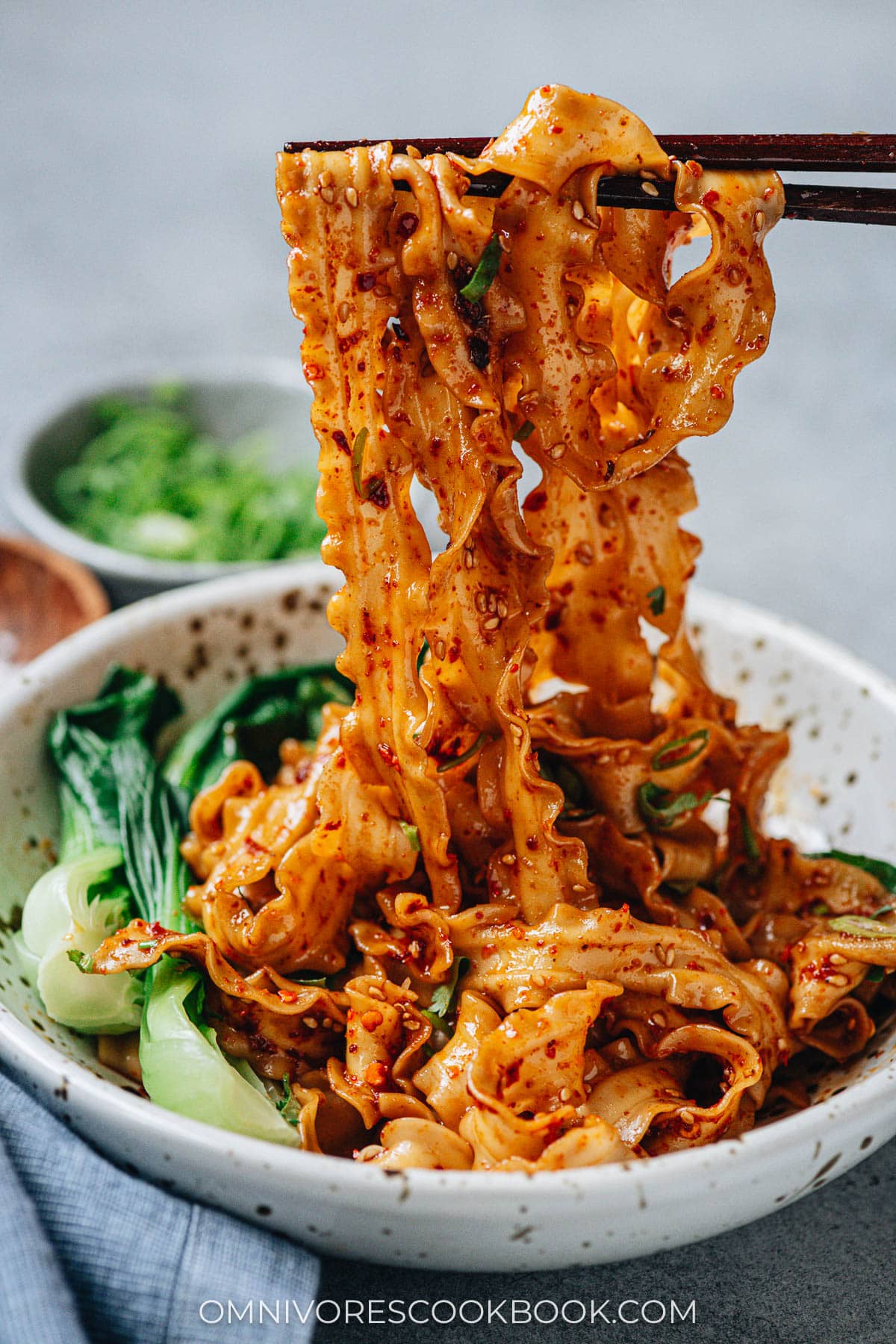
What is biang biang noodle?
Biang Biang noodles (also called Yu Po Mian, 油泼面) are a type of Chinese noodle originating from Shaanxi province. The word “biang” is an onomatopoeia – it mimics the sound made in the process of making the noodles, when the dough is pulled and slapped against the working surface.
Known for their length and thickness, these noodles are hand-pulled, creating a chewy texture. They are served in a spicy, tangy sauce made with chili oil, soy sauce, vinegar, ginger, garlic and Sichuan peppercorns. The dish is known for its bold flavors and distinctive preparation method by pouring hot oil into the spices (literally translated to Yu Po, or pouring hot oil).
The character for “biang” is also famously complex, with many strokes, making it one of the most intricate Chinese characters.
If you try this dish even once, you will see that its popularity comes from its simplicity and deep flavor, and it stands out as a wonderful example of what I share in my Authentic Chinese noodle recipes roundup.
Why this recipe
I had the best bowl of Biang Biang noodles when I was visiting Xi’an (the city of origin for this dish) with my husband Thomas. It wasn’t even a famous restaurant, just a random small shop that we came across on the side of the road. The big bowl of fat noodles was topped with a savory tomato sauce, and a complex and well balanced chili sauce. It was so simple, yet also rich and satisfying.
When trying to recreate the Xi’an version of these noodles at home, I tried several methods and finally found a perfect one. My recipe uses:
- Well balanced savory sauces with soy sauce, vinegar, and sesame oil for the base.
- Chili flakes with other hidden flavors such as Sichuan peppercorns and cumin powder for a more complex chili oil.
- A simple two-ingredient tomato sauce to further enhance the taste and texture, rounding out the spiciness of the chili oil.
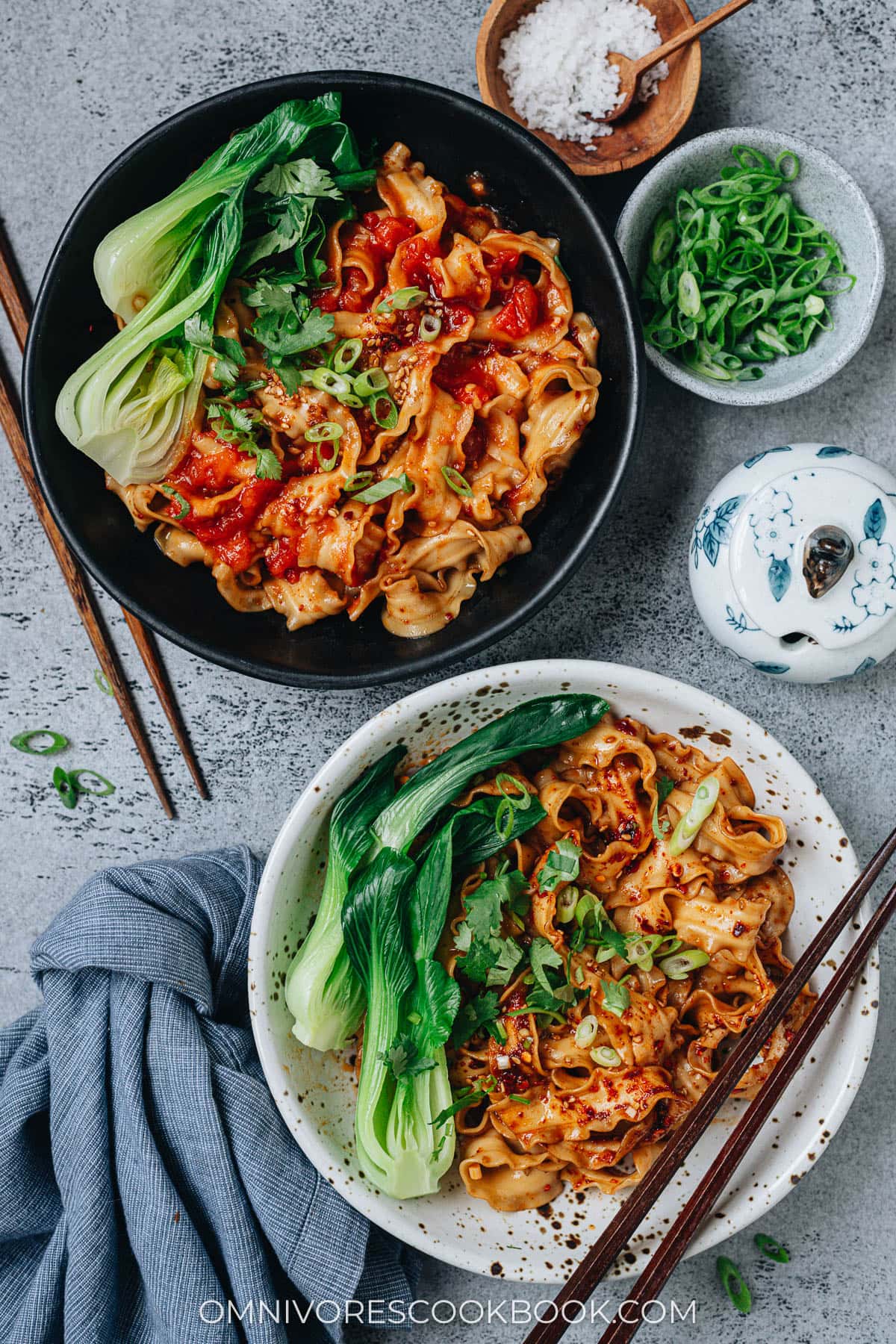
Ingredients for biang biang noodles
What type of noodles to use
Noodles are one of the most important components of the dish. For the best result, I highly recommend making your own hand-pulled noodles (the extra wide type in my recipe). It yields chewy noodles with the best texture.
The next best option is semi-fresh noodles that have a wide shape. The Havista brand Shan Xi Pull Noodles and Shanxi Planed Noodles are both great options. For these noodles, you can often find them in the refrigerated section of Chinese grocery stores or large Asian markets such as H-Mart.
In my recipe, I used the Dried Wide Knife Cut Noodles from The Mala Market. You can purchase them online and they stay in your pantry much longer.
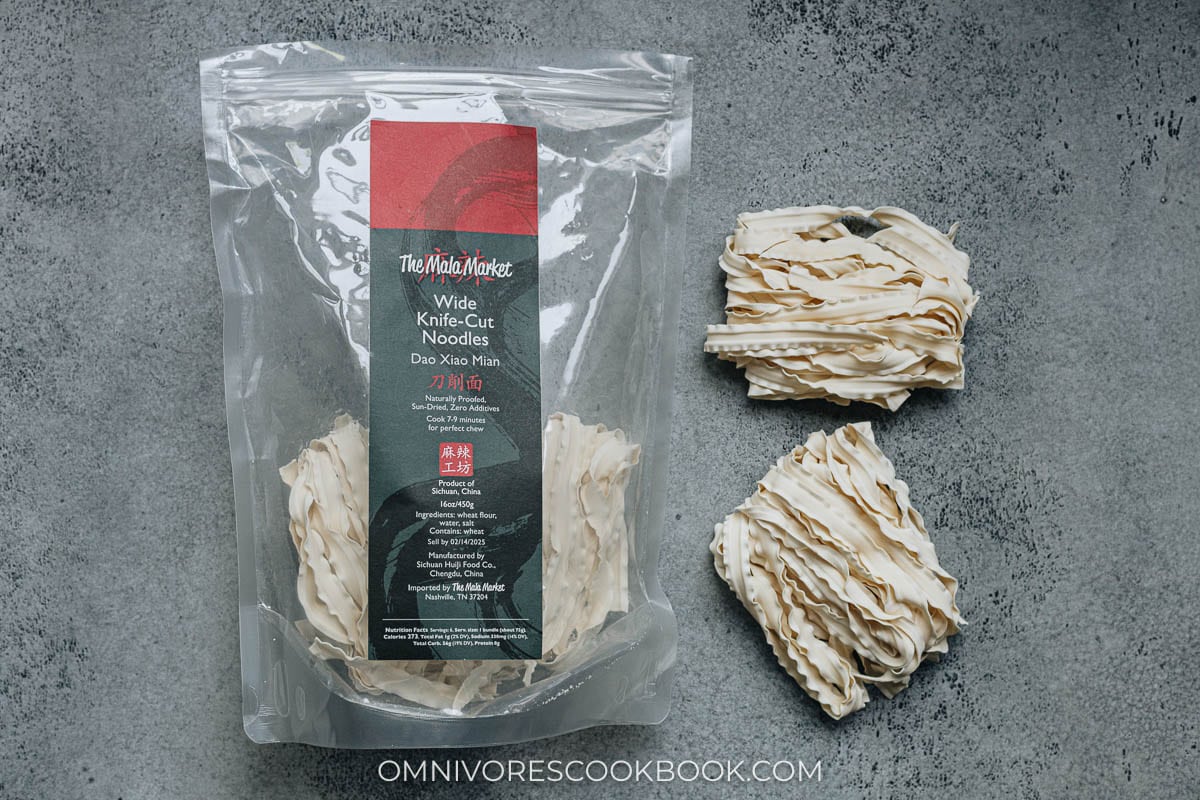
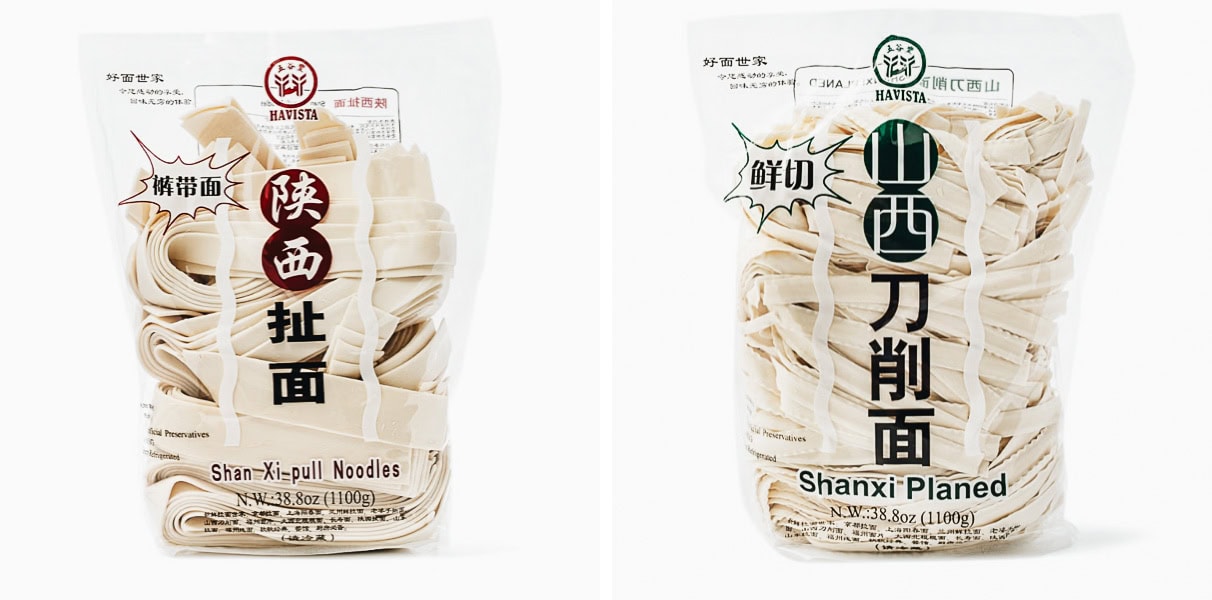
Chinese chili flakes (辣椒面)
Chili flakes are another important ingredient. To prepare biang biang noodles, you will be pouring hot oil over the chili flakes and other spices to make a chili oil. And chili flakes are the main ingredient for a great tasting sauce. The Chinese chili flakes used in this recipe are a coarse ground blend with a few types of Chinese chili peppers, ranging from smoky peppers to spicy peppers. The chili oil made with these chili flakes is moderately spicy and very fragrant, with a beautiful bright red color.
I highly recommend the chili flakes from The Mala Market, because they source the freshest spices directly from Sichuan, China.
Other seasonings
Chinese soy sauce (both the light and the dark type) and Chinkiang vinegar make the base of the biang biang noodle sauce.
I also used Sichuan peppercorns and cumin powder as hidden ingredients.
Fresh ginger, garlic and green onion, plus sesame oil add extra aroma and umami to the dish.
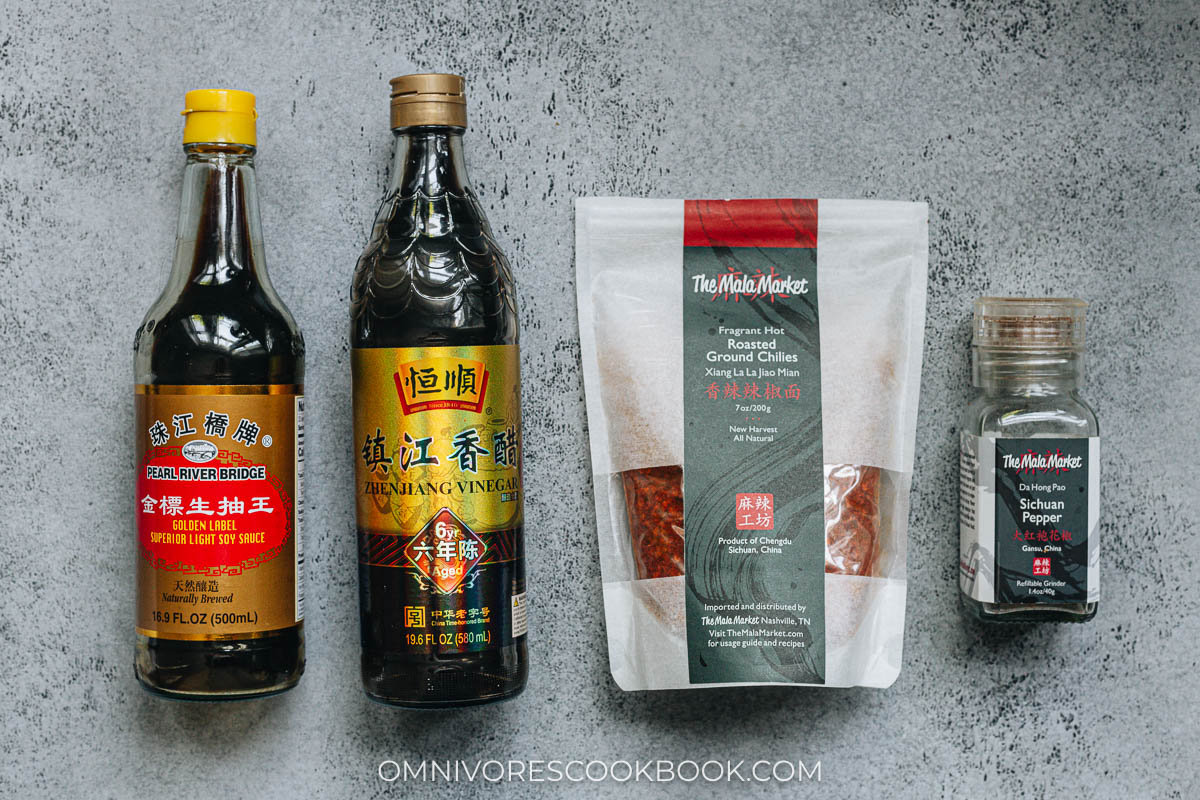
How to make biang biang noodles
Making biang biang noodles requires a few simple steps:
- Make a simple two ingredient tomato sauce
- Blanch baby bok choy (or any veggies you’d like to top on your noodles)
- Boil the noodles
- Mix the sauce base
- Toss the noodles in the sauce
- Spread the spices and aromatics on top of the noodles
- Heat hot oil and pour it over the spices to cook them
- Immediately mix everything together
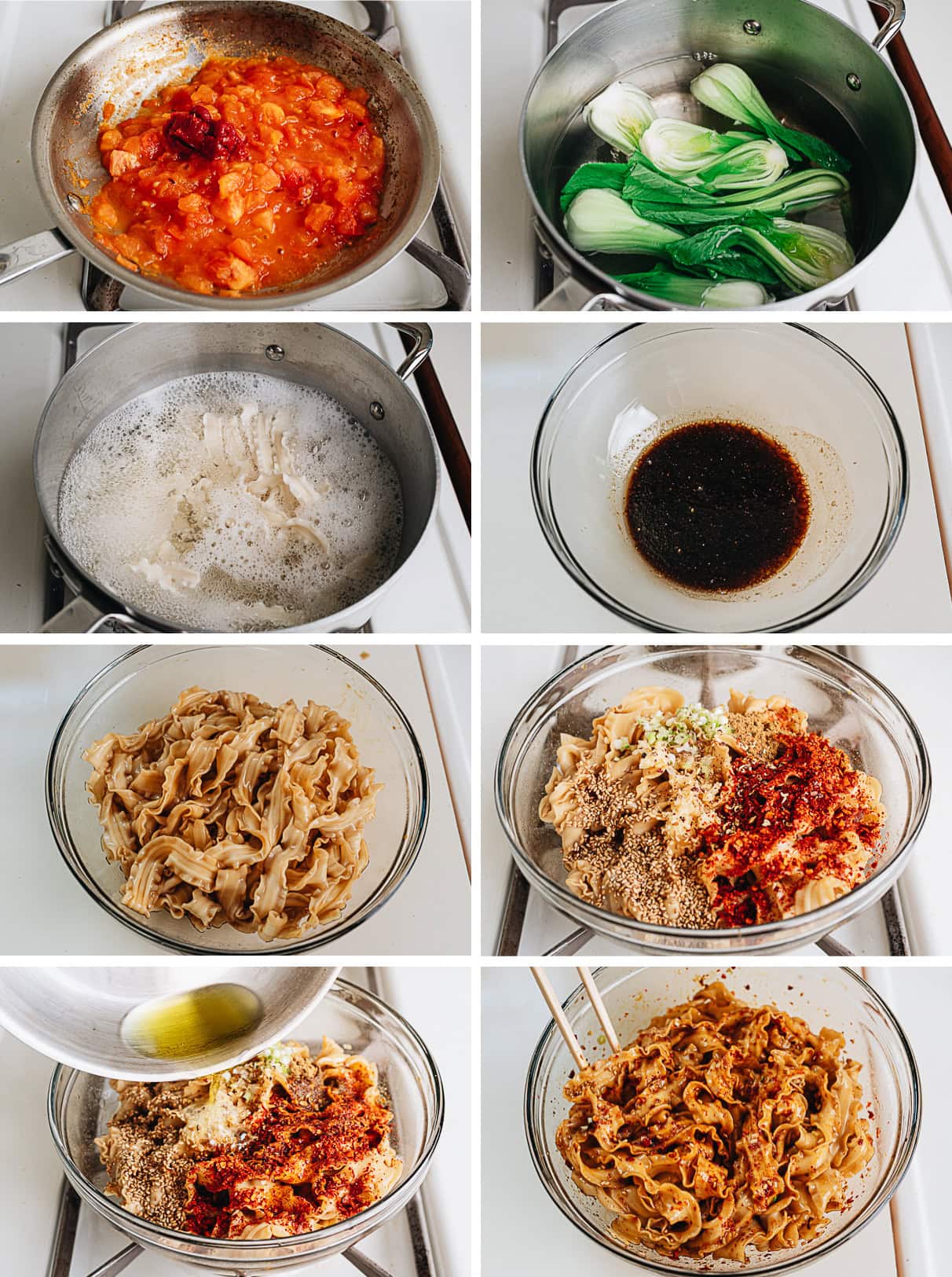
The hot oil will briefly cook the spices and aromatics, making a fresh rich chili oil that is bursting with umami. It’s important to spread the spices evenly, then drizzle the hot oil onto all the spices, as much as possible. The hot oil draws out the fragrance of the ingredients and makes the sauce extra delicious.
I like to add a tomato sauce onto my biang biang noodles. The sour taste and tender texture of the tomato balance out the spiciness of the chili oil, making the dish more rounded with a better mouthfeel. But it’s also OK to skip the tomato sauce, if you prefer to keep the dish very simple.
If you order biang biang noodles in China, the restaurants usually assemble the noodles and the spices individually. In this recipe, I made two servings together in a big bowl so it cuts down on the cooking steps.
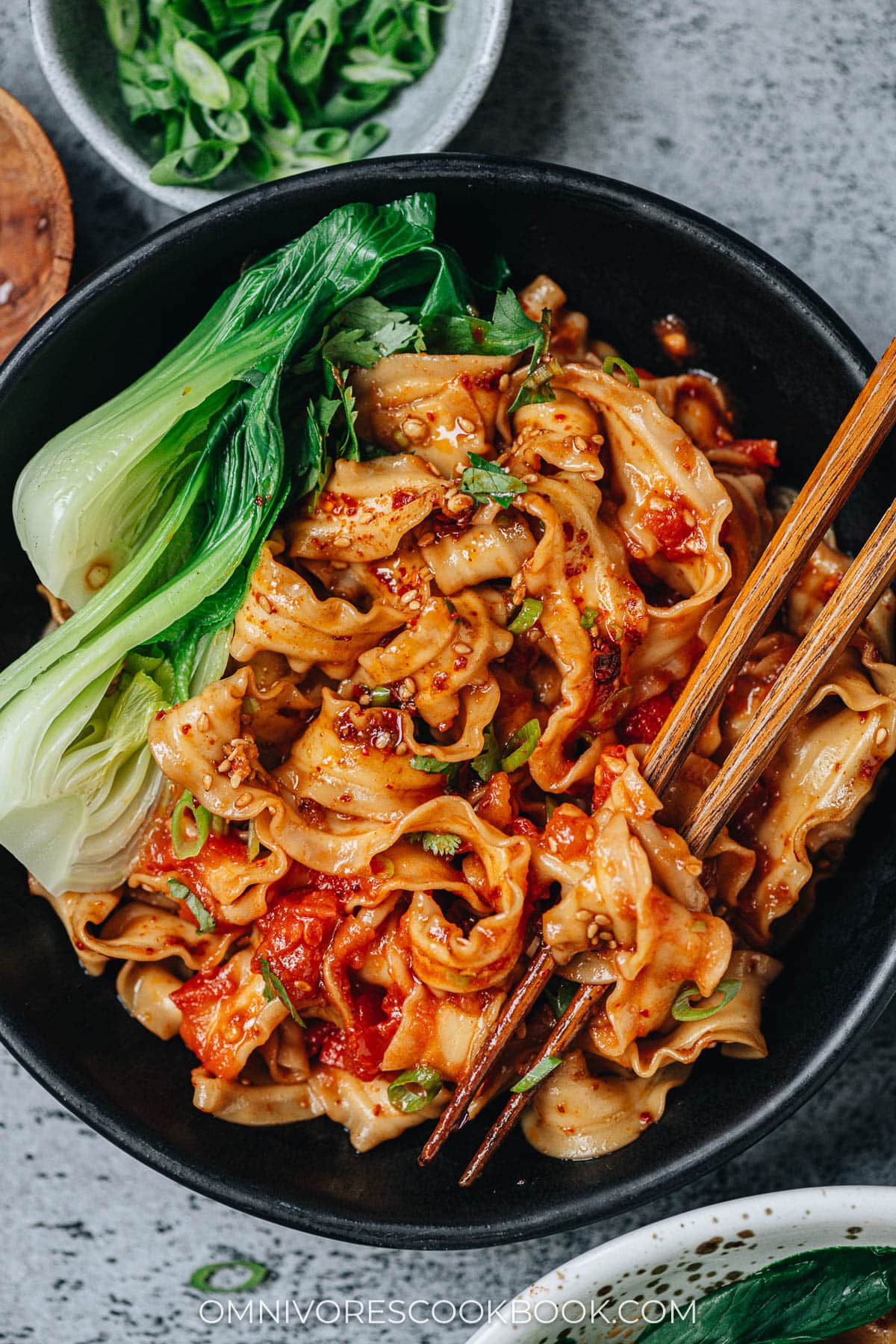
How to serve biang biang noodles
You can serve biang biang noodles as a side dish or a main dish for a light lunch. In China, it is often served as a savory snack that you can enjoy at any time of day.
You can pair biang biang noodles with these dishes for a satisfying meal:
- Cucumber salad
- Xinjiang Lamb Skewers (新疆烤串, chuar)
- Air Fryer Salt and Pepper Chicken
- Chinese Corn Soup with Chicken (鸡蛋玉米羹)
- Chinese Beef Salad
- Pork and Cabbage Stir Fry
- Dried Tofu and Celery Stir Fry (西芹炒香干)
Chinese Cooking Made Easy
Are you new to this website? This free email series is a great place to start. I’ll walk you through a few of my most popular recipes and show you how and why they work. You’ll quickly start to cook better Chinese food in your own kitchen.
Watch video
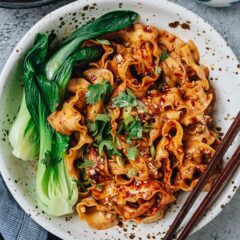
Biang Biang Noodles (Yu Po Mian)
Ingredients
Tomato sauce (optional but recommended)
- 1 tablespoon peanut oil (or vegetable oil)
- 2 tomatoes , diced
- Pinch of salt
- 1 tablespoon tomato paste
Noodle sauce
- 1 tablespoon light soy sauce
- 1 tablespoon Chinkiang vinegar
- 1/4 teaspoon dark soy sauce (optional)
- 1 teaspoon sugar
- 1 teaspoon sesame oil
- 1 green onion , white part minced, green part sliced for garnish
- 3 cloves garlic , grated
- 1 tablespoon Chinese chili flakes
- 1 tablespoon toasted white sesame seeds
- 1/4 teaspoon cumin powder
- 1/4 teaspoon ground Sichuan peppercorn (optional but highly recommended)
- 3 tablespoons peanut oil (or vegetable oil)
Noodles
- 2 bundles (150 g) dried knife shaved noodles (or 400 g fresh wide noodles or hand pulled-noodles)
- 4 heads baby bok choy , tough ends removed and cut into large bite size pieces (*Footnote 1)
- Chopped cilantro for garnish (Optional)
Instructions
Make tomato sauce
- Add 1 tablespoon of oil into a medium-sized skillet and heat over medium heat until hot. Add the tomato and a pinch of salt. Chop and stir the tomatoes until the tomato pieces break down, 4 to 5 minutes. Pour in a small splash of water if the pan becomes too dry. Add the tomato paste. Keep stirring for 1 minute until the tomato paste is evenly mixed. Transfer to a bowl and set aside.
Assemble noodles
- Combine the soy sauce, Chinkiang vinegar, sesame oil and sugar in a large bowl. Stir to mix until the sugar has dissolved.
- Bring a large pot of water to a boil. Blanch the baby bok choy for 2 minutes or so, until tender. Transfer the bok choy to a plate to cool off.
- In the same pot, boil the noodles according to instructions. Once the noodles are done, quickly rinse with running tap water to stop cooking. Then drain thoroughly and transfer to the bowl with the soy sauce mixture. Stir to combine.
- Add the white part of the green onion, garlic, chili flakes, sesame seeds, cumin powder and ground Sichuan peppercorn on top of the noodles.
- Heat the oil in a small saucepan over medium heat until hot. Immediately pour the hot oil over the noodles, covering as much seasoning as possible. Then stir everything together to mix well while the oil is still hot.
- Add the tomato sauce and mix again (if using).
- Garnish with baby bok choy and cilantro. Serve immediately.
Notes
- Other Chinese greens like choy sum, gai lan, and pea shoots all work well. You can also cut up some cucumber and top it on the noodles directly.
Nutrition

Did you make this recipe?
I’d love to hear how it turned out for you! Please take a moment to leave a 5-star rating ⭐️ and share your thoughts in the comments further down the page. It really helps others discover the recipe too.

Susan
Please send link to original soy sauce recipe
Paulina
Missing the original recipe, too! It was sooo good and I always made my Biang Biang noodles with the other recipe…
Can I find it somewhere?
Gabe
What is the original recipe for the chili oil??
Maggie Zhu
Here is the recipe for chili oil: https://omnivorescookbook.com/how-to-make-chili-oil/
Gabe Ziaukas
Thanks, Maggie! I love the original recipe (even though it had a bunch of steps). What were the aromatics in the seasoned soy sauce? I remember there being cloves or maybe cardamom and maybe a cinnamon stick (??) Love your recipes, they are crowd pleasers.
Cherry
Mmmm this recipe was yummy! I made it with 10oz of plant-based noodles from the store because that’s what I could find, and it was perfect. I loved the sesame flavor of the sauce and the tomatoes rounded out the flavors well. Served with your spicy cucumber sald too, thanks Maggie 🙂
Bill Zigrang
Maggie,
I just reviewed the blog post, printed recipe and all (old & new) reader’s comments.
1. If you just work from the printed recipe, there’s no mention of cooking the (dried) noodles – it looks like you want the hot oil poured over the spices & uncooked noodles.
2. the reader’s comments mention flavored soy sauce, but there’s no mention of it in this version of the recipe.
Just want to give you a chance to make any corrections to the printed recipe you might feel warranted.
Maggie Zhu
Thanks so much for pointing out the missed step! I just added the noodle cooking instruction back to the recipe.
Re flavored soy sauce – I decided to eliminate this ingredient when I update my old recipe, because it adds too many steps. I think the simplified version tastes great without it.
Bill Zigrang
Not a problem; also, you didn’t mention blanching the bok choy in the printed recipe. Feel free to delete these posts after you’ve made any changes felt necessary.
Maggie Zhu
Ugh can’t believe I had so many typos. Thanks for pointing it out again 🙏
Mimi
Your recipes are great. I bought a bottle of shanxi wine, mistakenly when I wanted to buy black vinegar. I read that you use shanxi vinegar for this bian bian noodles, but you used chinkiang vinegar in this recipe. Can you elaborate, and do you have any recipes I can use this bottle of shanxi vinegar for? Thank you!
Maggie Zhu
You can definitely use Shanxi vinegar in this one. It is stronger than the Chinkiang so you might need to slightly reduce the amount and add some sugar to balance out the taste. I use chinkiang vinegar in most of my recipes just because it’s more common and easier to find.